Thermal engineering calculation of a building: specifics and formulas for performing calculations + practical examples
During the operation of the building, both overheating and freezing are undesirable.Thermal engineering calculations, which are no less important than calculating efficiency, strength, fire resistance, and durability, will allow you to determine the golden mean.
Based on thermal engineering standards, climatic characteristics, steam and moisture permeability, materials for the construction of enclosing structures are selected. We will look at how to perform this calculation in the article.
The content of the article:
Purpose of thermal engineering calculation
Much depends on the thermal technical features of the building's permanent enclosures. This includes the humidity of structural elements and temperature indicators, which affect the presence or absence of condensation on interior partitions and ceilings.
The calculation will show whether stable temperature and humidity characteristics will be maintained at plus and minus temperatures. The list of these characteristics also includes such an indicator as the amount of heat lost by the building envelope during the cold period.
You can't start designing without having all this data. Based on them, the thickness of the walls and ceilings and the sequence of layers are chosen.
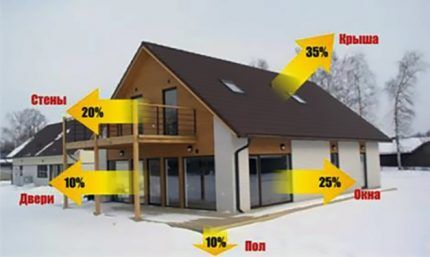
Thermal engineering calculation aims to determine:
- Are the designs identical to the stated requirements in terms of thermal protection?
- How fully is a comfortable microclimate inside the building ensured?
- Is optimal thermal protection of structures provided?
The main principle is maintaining a balance of the difference in temperature indicators of the atmosphere of internal structures of fences and premises. If this is not followed, heat will be absorbed by these surfaces and the temperature inside will remain very low.
The internal temperature should not be significantly affected by changes in heat flow. This characteristic is called heat resistance.
By performing a thermal calculation, the optimal limits (minimum and maximum) of the dimensions of walls and ceiling thicknesses are determined. This guarantees the operation of the building over a long period, both without extreme freezing of structures or overheating.
Options for performing calculations
To perform heat calculations, you need initial parameters.
They depend on a number of characteristics:
- Purpose of the building and its type.
- Orientations of vertical enclosing structures relative to the cardinal directions.
- Geographical parameters of the future home.
- The volume of the building, its number of storeys, area.
- Types and dimensions of door and window openings.
- Type of heating and its technical parameters.
- Number of permanent residents.
- Materials for vertical and horizontal fencing structures.
- Upper floor ceilings.
- Hot water supply equipment.
- Type of ventilation.
Other design features of the structure are also taken into account when calculating. The air permeability of enclosing structures should not contribute to excessive cooling inside the house and reduce the thermal protection characteristics of the elements.
Heat loss is also caused by waterlogging of the walls, and in addition, this entails dampness, which negatively affects the durability of the building.
In the calculation process, first of all, the thermal technical data of the building materials from which the building’s enclosing elements are made are determined. In addition, the reduced heat transfer resistance and compliance with its standard value are subject to determination.
Formulas for making calculations
Heat loss from a home can be divided into two main parts: losses through the building envelope and losses caused by the operation of the building. ventilation system. In addition, heat is lost when warm water is discharged into the sewer system.
Losses through building envelopes
For the materials from which the enclosing structures are constructed, it is necessary to find the value of the thermal conductivity index Kt (W/m x degree). They are in the relevant reference books.
Now, knowing the thickness of the layers, according to the formula: R = S/Kt, calculate the thermal resistance of each unit. If the structure is multilayer, all obtained values are added together.

Guided by this methodology, they take into account the fact that the materials that make up the structure have a different structure. It is also taken into account that the heat flow passing through them has different specifics.
For each individual structure, heat loss is determined by the formula:
Q = (A / R) x dT
Here:
- A is the area in m².
- R is the resistance of the structure to heat transfer.
- dT is the temperature difference between outside and inside.It needs to be determined for the coldest 5-day period.
Performing the calculation in this way, you can get the result only for the coldest five-day period. The total heat loss for the entire cold season is determined by taking into account the dT parameter, taking into account not the lowest temperature, but the average one.
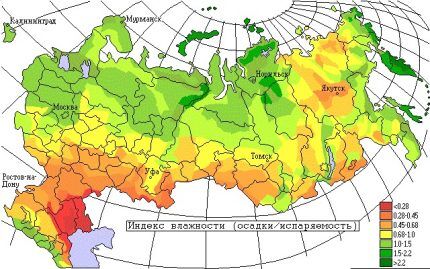
Next, the amount of energy required to compensate for heat loss lost both through the building envelope and through ventilation is calculated. It is denoted by the symbol W.
There is a formula for this:
W = ((Q + Qв) x 24 x N)/1000
In it, N is the duration of the heating period in days.
Disadvantages of area calculation
Calculation based on the area indicator is not very accurate. Here, such parameters as climate, temperature indicators, both minimum and maximum, and humidity are not taken into account. Due to ignoring many important points, the calculation has significant errors.
Often trying to cover them, the project includes a “reserve”.
If, nevertheless, this method is chosen for calculation, the following nuances must be taken into account:
- If the height of vertical fences is up to three meters and there are no more than two openings on one surface, it is better to multiply the result by 100 W.
- If the project includes a balcony, two windows or a loggia, multiply by an average of 125 W.
- When the premises are industrial or warehouse, a multiplier of 150 W is used.
- If radiators are located near windows, their design capacity is increased by 25%.
The formula for area is:
Q=S x 100 (150) W.
Here Q is the comfortable heat level in the building, S is the heated area in m². The numbers 100 or 150 are the specific amount of thermal energy consumed to heat 1 m².
House ventilation losses
The key parameter in this case is the air exchange rate. Provided that the walls of the house are vapor-permeable, this value is equal to one.

It is envisaged that the air inside the building will be completely renewed in one hour. Buildings built according to the DIN standard have walls with vapor barriers, so here the air exchange rate is taken to be two.
There is a formula that determines heat loss through the ventilation system:
Qv = (V x Kv: 3600) x P x C x dT
Here the symbols mean the following:
- Qв - heat loss.
- V is the volume of the room in mᶾ.
- P is the air density. its value is taken equal to 1.2047 kg/mᶾ.
- Kv - air exchange rate.
- C is the specific heat capacity. It is equal to 1005 J/kg x C.
Based on the results of this calculation, it is possible to determine the power of the heat generator of the heating system. If the power value is too high, the solution to the situation may be ventilation device with recuperator. Let's look at a few examples for houses made of different materials.
Example of thermal engineering calculation No. 1
Let's calculate a residential building located in climatic region 1 (Russia), subdistrict 1B. All data is taken from table 1 of SNiP 23-01-99. The coldest temperature observed over five days with a probability of 0.92 is tн = -22⁰С.
In accordance with SNiP, the heating period (zop) lasts 148 days. The average temperature during the heating period with the average daily air temperature outside is 8⁰ - tot = -2.3⁰. The outside temperature during the heating season is tht = -4.4⁰.

The condition was stipulated that the temperature in the rooms of the house should be 22⁰. The house has two floors and walls 0.5 m thick. Its height is 7 m, its plan dimensions are 10 x 10 m. The material of the vertical enclosing structures is warm ceramics. For it, the thermal conductivity coefficient is 0.16 W/m x C.
Mineral wool was used as external insulation, 5 cm thick. The Kt value for it is 0.04 W/m x C. The number of window openings in the house is 15 pcs. 2.5 m² each.
Heat loss through walls
First of all, you need to determine the thermal resistance of both the ceramic wall and the insulation. In the first case, R1 = 0.5: 0.16 = 3.125 sq. m x C/W. In the second - R2 = 0.05: 0.04 = 1.25 sq. m x C/W. In general, for a vertical building envelope: R = R1 + R2 = 3.125 + 1.25 = 4.375 sq. m x C/W.
Since heat loss is directly proportional to the area of the enclosing structures, we calculate the area of the walls:
A = 10 x 4 x 7 – 15 x 2.5 = 242.5 m²
Now you can determine heat loss through the walls:
Qс = (242.5: 4.375) x (22 – (-22)) = 2438.9 W.
Heat loss through horizontal enclosing structures is calculated in a similar way. In the end, all the results are summed up.
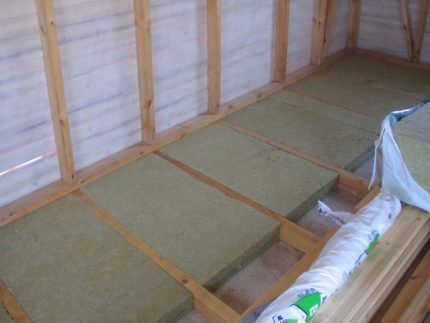
If the basement under the floor of the first floor is heated, the floor does not need to be insulated. It is still better to line the basement walls with insulation so that the heat does not escape into the ground.
Determination of losses through ventilation
To simplify the calculation, they do not take into account the thickness of the walls, but simply determine the volume of air inside:
V = 10x10x7 = 700 mᶾ.
With an air exchange rate of Kv = 2, the heat loss will be:
Qв = (700 x 2) : 3600) x 1.2047 x 1005 x (22 – (-22)) = 20,776 W.
If Kv = 1:
Qв = (700 x 1) : 3600) x 1.2047 x 1005 x (22 – (-22)) = 10,358 W.
Rotary and plate heat exchangers provide effective ventilation of residential buildings. The efficiency of the former is higher, it reaches 90%.
Example of thermal engineering calculation No. 2
It is required to calculate losses through a 51 cm thick brick wall. It is insulated with a 10 cm layer of mineral wool. Outside - 18⁰, inside - 22⁰. The dimensions of the wall are 2.7 m in height and 4 m in length. The only outer wall of the room is oriented to the south; there are no external doors.
For brick, the thermal conductivity coefficient Kt = 0.58 W/mºC, for mineral wool - 0.04 W/mºC. Thermal Resistance:
R1 = 0.51: 0.58 = 0.879 sq. m x C/W. R2 = 0.1: 0.04 = 2.5 sq. m x C/W. In general, for a vertical building envelope: R = R1 + R2 = 0.879 + 2.5 = 3.379 sq. m x C/W.
External wall area A = 2.7 x 4 = 10.8 m²
Heat loss through the wall:
Qс = (10.8: 3.379) x (22 – (-18)) = 127.9 W.
To calculate losses through windows, the same formula is used, but their thermal resistance, as a rule, is indicated in the passport and does not need to be calculated.
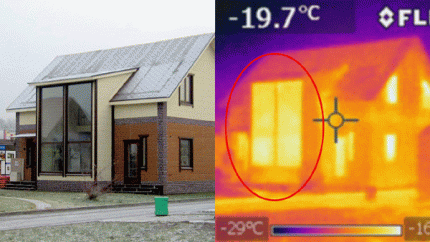
If the house has energy-saving windows measuring 1.5 x 1.5 m², oriented to the North, and the thermal resistance is 0.87 m2°C/W, then the losses will be:
Qо = (2.25: 0.87) x (22 – (-18)) = 103.4 t.
Example of thermal engineering calculation No. 3
Let's perform a thermal calculation of a wooden log building with a facade built from pine logs with a layer 0.22 m thick. The coefficient for this material is K = 0.15. In this situation, the heat loss will be:
R = 0.22: 0.15 = 1.47 m² x ⁰С/W.
The lowest temperature of the five-day period is -18⁰, for comfort in the house the temperature is set to 21⁰. The difference will be 39⁰. Based on an area of 120 m², the result will be:
Qс = 120 x 39: 1.47 = 3184 W.
For comparison, let’s determine the losses of a brick house. The coefficient for sand-lime brick is 0.72.
R = 0.22: 0.72 = 0.306 m² x ⁰С/W.
Qс = 120 x 39: 0.306 = 15,294 W.
Under the same conditions, a wooden house is more economical. Sand-lime brick is not suitable for building walls here at all.
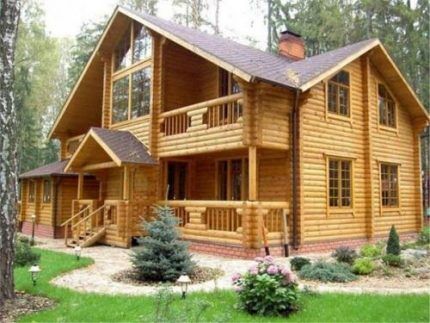
Builders and architects recommend that you definitely do heat calculation for heating installation for proper selection of equipment and at the house design stage for choosing a suitable insulation system.
Heat calculation example No. 4
The house will be built in the Moscow region. For the calculation, a wall made of foam blocks was taken. How the insulation is applied extruded polystyrene foam. The finishing of the structure is plaster on both sides. Its structure is limestone-sand.
Expanded polystyrene has a density of 24 kg/mᶾ.
Relative air humidity in the room is 55% at an average temperature of 20⁰. Layer thickness:
- plaster - 0.01 m;
- foam concrete - 0.2 m;
- expanded polystyrene - 0.065 m.
The task is to find the required and actual heat transfer resistance. The required Rtr is determined by substituting the values in the expression:
Rtr=a x GSOP+b
where GOSP is the degree-day of the heating season, a and b are coefficients taken from table No. 3 of the Code of Rules 50.13330.2012. Since the building is residential, a is 0.00035, b = 1.4.
GSOP is calculated using a formula taken from the same SP:
GOSP = (tv – tot) x zot.
In this formula, tв = 20⁰, tоt = -2.2⁰, zоt - 205 is the heating period in days. Hence:
GSOP = (20 – (-2.2)) x 205 = 4551⁰ C x day;
Rtr = 0.00035 x 4551 + 1.4 = 2.99 m2 x C/W.
Using table No. 2 SP50.13330.2012, determine the thermal conductivity coefficients for each layer of the wall:
- λb1 = 0.81 W/m ⁰С;
- λb2 = 0.26 W/m ⁰С;
- λb3 = 0.041 W/m ⁰С;
- λb4 = 0.81 W/m ⁰С.
The total conditional resistance to heat transfer Ro is equal to the sum of the resistances of all layers. It is calculated using the formula:

Substituting the values we get: Rо arb. = 2.54 m2°C/W. Rф is determined by multiplying Ro by a coefficient r equal to 0.9:
Rf = 2.54 x 0.9 = 2.3 m2 x °C/W.
The result requires changing the design of the enclosing element, since the actual thermal resistance is less than the calculated one.
There are many computer services that speed up and simplify calculations.
Thermal calculations are directly related to the determination dew point. You will learn what it is and how to find its meaning from the article we recommend.
Conclusions and useful video on the topic
Performing thermal engineering calculations using an online calculator:

Correct thermal engineering calculation:

A competent thermotechnical calculation will allow you to evaluate the effectiveness of insulating the external elements of the house and determine the power of the necessary heating equipment.
As a result, you can save money when purchasing materials and heating devices. It is better to know in advance whether the equipment can cope with the heating and air conditioning of the building than to buy everything at random.
Please leave comments, ask questions, and post photos related to the topic of the article in the block below. Tell us how thermal engineering calculations helped you choose heating equipment of the required power or insulation system. It is possible that your information will be useful to site visitors.




It’s interesting that in the age of the Internet and the availability of methods for such calculations, there are still cunning people who are trying to impose their thermal calculation services.
I’m talking about my management company now - they decided to estimate the heat loss of our high-rise building, and at the same time impose on the residents a price of many thousands for very complex and time-consuming calculations.
So far we have managed to fight off their “services”.